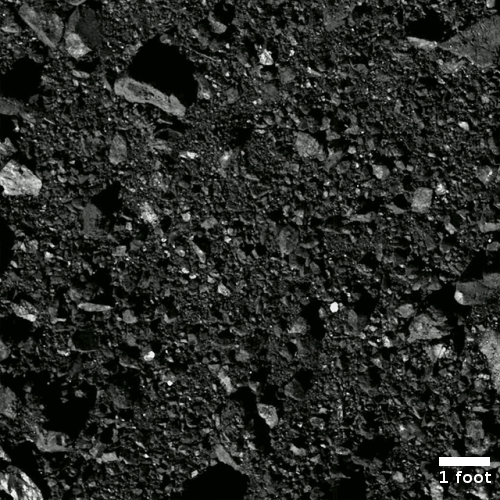What OSIRIS-REx will grab from the asteroid Bennu in October

On August 11th the spacecraft OSIRIS-REx did a sample grab-and-go rehearsal that put the spacecraft as close as 135 feet from the asteroid Bennu. During the rehearsal the spacecraft’s mapping camera (MapCam) snapped 22 images of the approach, showing the landing site, dubbed Nightingale, at the highest resolution yet.
From those images the science team created a movie. To the right is the closest image from that movie, lightened slightly and reduced to post here. It gives us the best view of the Nightingale landing site we will have prior to the October sample grab.
In essence, we are looking at the material that OSIRIS-REx will grab, though which particular rocks will be grabbed from this gravel pile are of course unknown. The spacecraft’s equipment is designed to capture pebbles smaller than 0.8 inches across. There are a good number of such rocks here, interspersed with a lot of larger rocks, including the several more than a foot across.
As I have noted previously, this landing site is about half the diameter of the landing sites the spacecraft was designed to touch down on. The rehearsal however gives us strong hope that OSIRIS-REx will be able to hit the bullseye. See this second movie, which shows the approach from two different cameras, with a wider context image provided to show how the spacecraft successfully hones in on its target.
On Christmas Eve 1968 three Americans became the first humans to visit another world. What they did to celebrate was unexpected and profound, and will be remembered throughout all human history. Genesis: the Story of Apollo 8, Robert Zimmerman's classic history of humanity's first journey to another world, tells that story, and it is now available as both an ebook and an audiobook, both with a foreword by Valerie Anders and a new introduction by Robert Zimmerman.
The print edition can be purchased at Amazon or from any other book seller. If you want an autographed copy the price is $60 for the hardback and $45 for the paperback, plus $8 shipping for each. Go here for purchasing details. The ebook is available everywhere for $5.99 (before discount) at amazon, or direct from my ebook publisher, ebookit. If you buy it from ebookit you don't support the big tech companies and the author gets a bigger cut much sooner.
The audiobook is also available at all these vendors, and is also free with a 30-day trial membership to Audible.
"Not simply about one mission, [Genesis] is also the history of America's quest for the moon... Zimmerman has done a masterful job of tying disparate events together into a solid account of one of America's greatest human triumphs."--San Antonio Express-News

On August 11th the spacecraft OSIRIS-REx did a sample grab-and-go rehearsal that put the spacecraft as close as 135 feet from the asteroid Bennu. During the rehearsal the spacecraft’s mapping camera (MapCam) snapped 22 images of the approach, showing the landing site, dubbed Nightingale, at the highest resolution yet.
From those images the science team created a movie. To the right is the closest image from that movie, lightened slightly and reduced to post here. It gives us the best view of the Nightingale landing site we will have prior to the October sample grab.
In essence, we are looking at the material that OSIRIS-REx will grab, though which particular rocks will be grabbed from this gravel pile are of course unknown. The spacecraft’s equipment is designed to capture pebbles smaller than 0.8 inches across. There are a good number of such rocks here, interspersed with a lot of larger rocks, including the several more than a foot across.
As I have noted previously, this landing site is about half the diameter of the landing sites the spacecraft was designed to touch down on. The rehearsal however gives us strong hope that OSIRIS-REx will be able to hit the bullseye. See this second movie, which shows the approach from two different cameras, with a wider context image provided to show how the spacecraft successfully hones in on its target.
On Christmas Eve 1968 three Americans became the first humans to visit another world. What they did to celebrate was unexpected and profound, and will be remembered throughout all human history. Genesis: the Story of Apollo 8, Robert Zimmerman's classic history of humanity's first journey to another world, tells that story, and it is now available as both an ebook and an audiobook, both with a foreword by Valerie Anders and a new introduction by Robert Zimmerman.
The print edition can be purchased at Amazon or from any other book seller. If you want an autographed copy the price is $60 for the hardback and $45 for the paperback, plus $8 shipping for each. Go here for purchasing details. The ebook is available everywhere for $5.99 (before discount) at amazon, or direct from my ebook publisher, ebookit. If you buy it from ebookit you don't support the big tech companies and the author gets a bigger cut much sooner.
The audiobook is also available at all these vendors, and is also free with a 30-day trial membership to Audible.
"Not simply about one mission, [Genesis] is also the history of America's quest for the moon... Zimmerman has done a masterful job of tying disparate events together into a solid account of one of America's greatest human triumphs."--San Antonio Express-News


I’d like to see you make a comparison between OSIRIS-Rex and Hayabusa-2.
I think the former seems very anxious and problematic, while the latter already has sent its sample back to Earth and is looking for a second asteroid to study. Although OSIRIS-Rex is 5 times as expensive as Hayabusa-2.